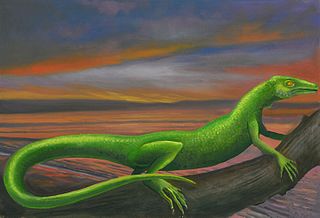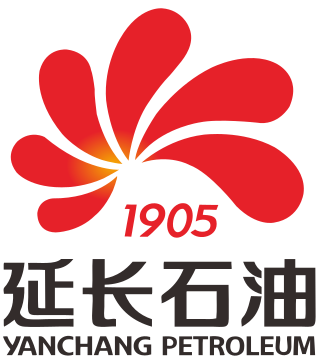Related Research Articles

Klamelisaurus is a genus of herbivorous sauropod dinosaur from the Middle Jurassic Shishugou Formation of China. The type species is Klamelisaurus gobiensis, which was named by Zhao Xijin in 1993, based on a partial skeleton discovered in 1982 near the abandoned town of Jiangjunmiao. Zhao described Klamelisaurus as the only member of a new subfamily, Klamelisaurinae, among the now-defunct primitive sauropod order Bothrosauropodoidea. Since Zhao's description, Klamelisaurus received limited attention from researchers until Andrew Moore and colleagues redescribed it in 2020.

Thadeosaurus is an extinct genus of diapsid reptile belonging to the family Younginidae. Fossils have been found in the Lower Sakamena Formation of the Morondava Basin, Madagascar in 1981, and date to the late Permian to the early Triassic period.
Tsimiroro is a large oil field in the onshore Morondava Basin of Madagascar found south of the Bemolanga ultra heavy oil field and south of the town of Morafenobe. It is estimated to contain as many as 9.3 billion barrels (1.48×109 m3) of heavy oil with 14° to 16° API gravity. The oil is found in the Isalo and Amboloando formations.
Bemolanga is a large oil sands deposit in the onshore Morondava Basin of Madagascar. The deposit was discovered in the early 1900s but was known to locals for centuries. The field is located north of the Tsimiroro heavy oil field and east of the town of Morafenobe. The field is at 0–30 metres (0–98 ft) depth and about 120 kilometres (75 mi) from the coast.

Madagascar Oil SA is an oil company operating in Madagascar. It is the principal onshore oil company in Madagascar in terms of oil resources and land.
Articles related to Madagascar include:
Nanningosaurus is a genus of hadrosaurid dinosaur from the upper Late Cretaceous of the Nalong Basin, Guangxi, China.

Betania is a coastal village in Western Madagascar south of Morondava with a population of around 2,400 Vezo fishermen. This village belongs to the municipality of Morondava and is situated on the southern side of the mouth of the Morondava River.

Tropical Cyclone Elita was an unusual tropical cyclone that made landfall on Madagascar three times. The fifth named storm of the 2003–04 South-West Indian Ocean cyclone season, Elita developed in the Mozambique Channel on January 24, 2004. It strengthened to tropical cyclone status before striking northwestern Madagascar on January 28; it was the first storm to strike western Madagascar at that intensity since Cyclone Cynthia in 1991. Elita weakened to tropical depression status while crossing the island, and after exiting into the southwest Indian Ocean, it turned to the west and moved ashore in eastern Madagascar on January 31. After once again crossing the island, the cyclone reached the Mozambique Channel and re-intensified. Elita turned to the southeast to make its final landfall on February 3 along southwestern Madagascar. Two days later, it underwent an extratropical transition; subsequently, the remnant system moved erratically before dissipating on February 13.

Shaanxi Yanchang Petroleum Group is a Chinese conglomerate mainly engaged in the exploration, production, transportation, and sale of petroleum and natural gas, and in addition the production and sales of petrochemical products. Founded in 1905, it is the fourth largest oil producer in the country. Almost all its reserves and refineries are located in Shaanxi.

Tangasauridae is an extinct family of diapsids known from fossil specimens from Madagascar, Kenya and Tanzania that are Late Permian to Early Triassic in age. Fossils have been found of numerous specimens of common members of this family such as Hovasaurus in different stages of ontogenic development. Recent material from the Middle Sakamena Formation of the Morondava Basin of Madagascar that dates back to the early Triassic period suggests that the Tangasauridae were relatively unaffected by the Permian-Triassic extinction event.
Niko Resources is an India- and South East Asia-focused oil and gas exploration and production company that shares ownership of many exploration and development properties with Komodo Energy and Reliance Industries. Though it holds exploration rights to 37,000,000 acres (150,000 km2) of land in 7 countries production currently (2011) only takes place in India and Bangladesh. Major acquisitions include a $310 million November 18, 2009 purchase of Black Gold Energy followed by the 2010 $37.6 million acquisition of Voyager Energy which expanded its presence in Trinidad.
Energy in Algeria encompasses the production, consumption, and import of energy. As of 2009, the primary energy use in Algeria was 462 TWh, with a per capita consumption of 13 TWh. Algeria is a significant producer and exporter of oil and gas and has been a member of the Organization of the Petroleum Exporting Countries (OPEC) since 1969. It also participates in the OPEC+ agreement, collaborating with non-OPEC oil-producing nations. Historically, the country has relied heavily on fossil fuels, which are heavily subsidized and constitute the majority of its energy consumption. In response to global energy trends, Algeria updated its Renewable Energy and Energy Efficiency Development Plan in 2015, aiming for significant advancements by 2030. This plan promotes the deployment of large-scale renewable technologies, such as solar photovoltaic systems and onshore wind installations, supported by various incentive measures.

The geology of Madagascar comprises a variety of rocks of Precambrian age which make up the larger part of the east and centre of the island. They are intruded by basalts and rhyolites of Mesozoic to Cenozoic age. In contrast, the western part of the island is formed from sedimentary rocks of Carboniferous to Quaternary age. Archean rocks occur from the northeast portion of the island down to the south in the Ranotsara shear zone. Rocks in the northern portion of Madagascar are greenstone belts, from the Archean or Paleoproterozoic age.
The Bemaraha Formation is a Middle Jurassic geological formation of the Morondava Basin of Madagascar. The lime mudstones, grainstones and limestones of the formation were deposited in lagoonal and reefal environments. Fossils of groups of invertebrates and theropod and sauropod tracks have been found in the formation. The Sahalaly River tracksite yielded a single trackway belonging to a quadrupedal dinosaur, possibly a sauropod. Sauropod tracks are rare, making up as little as 1 percent of the present sample. The best-preserved tracks are assigned to the ichnogenus Kayentapus.

The Junggar Basin, also known as the Dzungarian Basin or Zungarian Basin, is one of the largest sedimentary basins in Northwest China. It is located in Dzungaria in northern Xinjiang, and enclosed by the Tarbagatai Mountains of Kazakhstan in the northwest, the Altai Mountains of Mongolia in the northeast, and the Heavenly Mountains in the south. The geology of Junggar Basin mainly consists of sedimentary rocks underlain by igneous and metamorphic basement rocks. The basement of the basin was largely formed during the development of the Pangea supercontinent during complex tectonic events from Precambrian to late Paleozoic time. The basin developed as a series of foreland basins – in other words, basins developing immediately in front of growing mountain ranges – from Permian time to the Quaternary period. The basin's preserved sedimentary records show that the climate during the Mesozoic era was marked by a transition from humid to arid conditions as monsoonal climatic effects waned. The Junggar basin is rich in geological resources due to effects of volcanism and sedimentary deposition. According to Guinness World Records it is a land location remotest from open sea with great-circle distance of 2,648 km from the nearest open sea at 46°16′8″N86°40′2″E.

The Madagascar flood basalt, also known as the Madagascar large igneous province (LIP), is one of the major magmatic events of the Late Cretaceous. They cover a large area of basaltic and rhyolitic lava flows that erupted during an episode of widespread basaltic volcanism during the Cretaceous period. The flood basalts are characterized by lava flows, dykes, sills, and intrusions, and other volcanic features include plugs, scoria, and spatter cones. Tholeiitic basalt constitutes the primary rock type.
Isalo II, also known as the Makay Formation, is an informal Triassic geological unit in Madagascar.

The Liaohe Plain is a paddy plain located in the southern tip of Northeast China, part of the greater Northeast China Plain. The Liaohe Plain is one of the most important industrial zones in Liaoning, and with a cultivated land area of 144 million hectares, the area of the paddy-growing fields of its rice field station has increased by 977.1 sq km, from 1988 to 2006.
The Dazhang Formation is a geologic formation in China. It preserves fossils dating back to the late Paleocene, including those of plants and mammals. The formation is primarily composed of interbedded marl, oil shale, claystone and glutenite. Depending on the section, the color of the mudstone may vary from green, red-brown or gray-black.
References
- ↑ Wenxiang, He; Kaixi, Jiang; Huan, Wan; Qingzheng, Guo; Jingjing, Li; Caishun, Zhao (2017-09-30). "Heavy Oil Accumulation Characteristics of the Tsimiroro Oilfield in Morondava Basin, Eastern Africa". 地质科技通报 (in Chinese). 36 (5): 60–68. ISSN 2096-8523.
- ↑ Wu, Da-tian; Ramaniraka, Johanne Iomimalala; Xu, Feng-ming; Shao, Jian-bo; Zhou, Yong-heng; Zhao, Yuan-dong; Ralison, Bruno (2019-03-01). "Characteristics and potential analysis of Madagascar hydrocarbon-bearing basins". China Geology. 2 (1): 56–66. doi: 10.31035/cg2018076 . ISSN 2096-5192.